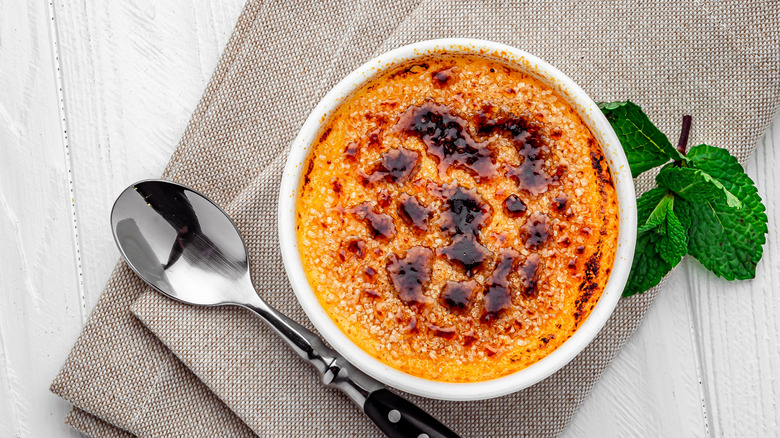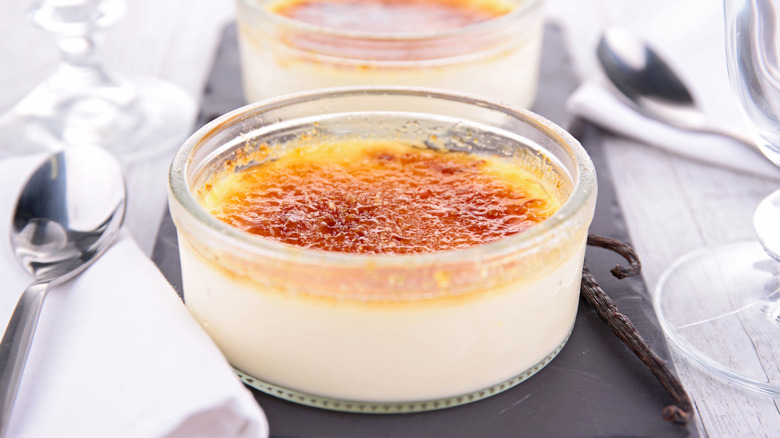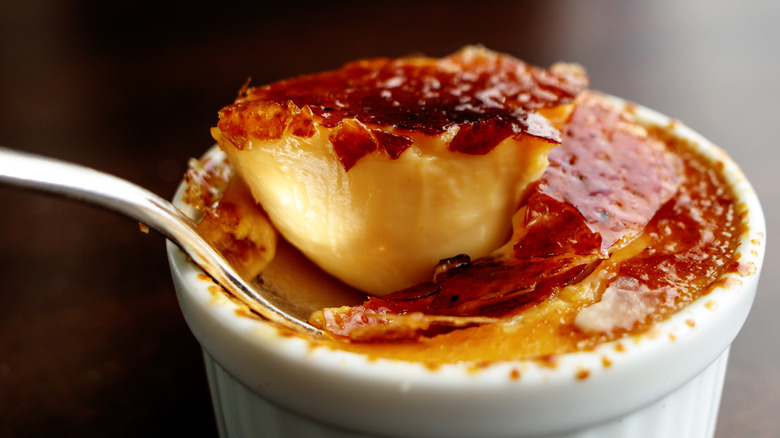Crème Brûlée Vs. Crema Catalana: What's The Difference?
Desserts weren't always as available to the general public as they are today. Around much of the globe, someone carving a sugary sweet dish can walk into a grocery store and grab a chocolate bar or a pint of Ben & Jerry's ice cream. But we tend to forget that there was a time in the world when candy was only consumed by the uber-wealthy and sugar was a rarity. However, that was a long time in history, especially European history, when the sweetest thing people ate were the wild fruits growing on trees and briars.
Sugar, as we recognize it today, didn't make its way to European shores until 1100 AD, but it was both incredibly rare and expensive, so it didn't become widely used outside of the hands of royalty until the 16th century, via Local Histories. Until then, desserts were pretty bland (or, in the fruitcake's case, reasonably boozy) until sugar made its way to the kitchen table, but once it did, desserts were being invented left and right. One of the first and favorite of these sweets were custards, which came in various flavors.
What is crème brûlée?
If you've stopped to eat at a French-inspired restaurant or had the opportunity to explore the food scene in Paris, you've definitely stumbled or perhaps fallen head-first into a bowl of crème brûlée. This custardy dish is a fan-favorite dessert worldwide and is famous for its rich, creamy flavor and hard sugar crust. The origin of this dish can be traced back to a recipe found in a 17th-century French cookbook, which Gambero Rosso International says was created by chef François Massialot, who worked in the Palace of Versailles. His recipe is a little different from what we consider crème brûlée today. Instead of heating a layer of sugar until it hardened, Massialot simply placed caramelized sugar on top. Now, crème brûlée can be found everywhere and is abundantly popular in its country of origin and the United States.
So, what exactly is this well-beloved dessert made of? According to Fernweh Editions, the creme brûlée is meant to have a flavor of vanilla or plain custard, a caramel note thanks to its crust, and is to be served cold with fresh fruit. This delicious concoction is made by heating and mixing cream, sugar, and egg yolks until the mixture is thick. The custard is then served in ramekins and completely cooled down before caramelizing the top, accomplished with a torch or with the help of a broiler.
What is crema catalana?
Crème brûlée sounds downright delicious and a hearty mix of sweet and creamy, but what if we told you about another custard-based dessert that is just as delicious? The crema catalana is much like the French crème brûlée but has some unique and distinct differences. The Hispanic Kitchen claims that crema catalana is a traditional Spanish sweet and is considered one of the oldest European desserts still in circulation today. It was created by the Jewish people residing in Catalonia, hence the name crema "catalana." It is now the official dessert served on St. Joseph's Day (March 19th) and the national dessert of Catalonia!
Though crème brûlée and crema catalana are custard desserts, they taste fairly different. The French crème brûlée relies on the natural sweetness of vanilla and caramelization on top for flavor, but the crema Catalana is more adventurous in taste. Daring Gourmet explains that the crema Catalana is authentically flavored with citrus (lemon and orange) and cinnamon, giving the custard some puckering acidity and a warm, toasty flavor as well. In addition, the custard base for the Spanish treat is made primarily with milk, not cream, as used in crème brûlée. This means the dish will be a little less firm but still be incredibly creamy and lighter than the French dessert. And, of course, it has the classic caramelized top to look forward to cracking through.


